CHAS. G. HOILES
GENERAL MERCHANDISE
1913-1916
SILVERHILL, ALABAMA
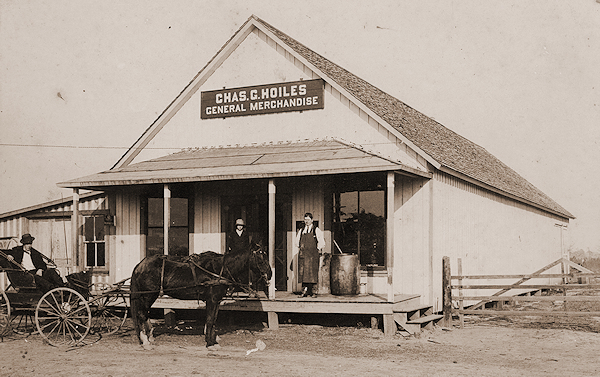
|
|
Hoiles Merchandise Store, Silverhill about 1913.
|

|
Charles Gee Hoiles was born 1879 in Alliance, Ohio. According to the 1900 Federal census, he was working as a grocery clerk in Chicago, Illinois, at the age of 21. In 1901, Charles married Hannah Hughes in Chicago. By 1907, they had three healthy sons, all born in the city. However, Chicago was not a healthy place to live. Factories, trains, and coal-burning fireplaces polluted the air, and crowded living spaces made it easier for diseases to spread. In October 1911, another son was born, but he lived only 3 days. Devastated, Charles considered his options in raising his young family. He wanted to find a good place to live.
|

Charles Gee Hoiles, wife Hannah, and three sons.
About 1910.
|
Hannah had already been sick when her son had died. February 1911, she was at The Gladstone Sanatorium in Black Mountain, North Carolina receiving medical treatment. Hannah was only one of many people who had been unwillingly swept into a global pandemic.
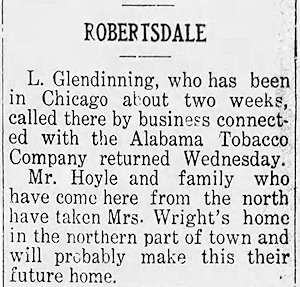
|
At the time, tuberculosis, also known as consumption or the white plague, was one of the leading causes of death in Chicago. Since an actual cure would be decades away, doctors took a more holistic approach to treatment. They advised people with the illness, if they could afford it, to move to areas with open space and clean air.
|
The newspaper above was taken from The Baldwin Times of Bay Minette printed October 24, 1912, announcing the Hoiles family had moved to Baldwin County, Alabama.
As advertised below, Silverhill was described as a wonderful place to live. Doctors were encouraged to consider Silverhill as an ideal place to build a Sanatorium for their sick and infirm. It attracted many people who were not only interested in buying farmland but also wanted to live in a warm, healthy environment. View the entire booklet here.

|
The above page is from an advertising brochure and translated by Ted Forsman. The translation reads:
The photograph is taken at Carl Vallentine's land, 3 miles from Silverhill.
The land is very inviting. There are no high hills. There are good streams with clear water.
There is no place more qualified to build a Sanatorium than Silverhill.
Doctors, pastors and others that are interested in a sanatorium for the sick and the feeble people, write to
SVEA LAND COLONY,
122 S. Clark Street, Suite 512, .....Chicago, Ill.
|
When Charles G. Hoiles and his family moved to Baldwin County, Alabama, he rented a home in Robertsdale. He immediately bought 20 acres of land just outside of Silverhill from a Swedish couple, paying $2,000. However, the Hoiles family was not of Swedish descent.

Newspaper article above taken from page one of The Onlooker of Foley printed November 12, 1913 about the Hoiles Store, with transcript at right.
|
SILVERHILL
A NEAT AND PROSPEROUS TOWN.
DALTON TO BUILD
BALDWIN BROS. WAREHOUSE.
ENTERTAINMENTS.
PERSONALS.
(Special to The Onlooker.)
(From) Robertsdale - Silverhill is a quiet little town three miles west of here. No railroad with smoky, sooty engine and rattling trains to mar the quiet and serenity. A couple of stores, post office, two or three neat churches with here and there a new building and many attractive residences. It is settled almost entirely by Swedish people, some of whom cling closely to the mother tongue and their own literature. There are fine farms in every direction from the town.
About a mile north we came upon a new building 30 x 80 ft., which proved to be a store. Some might deem it useless to build and stock a store with nothing like a customer near, but the owner Mr. Hoiles informed us he had a fine trade and we began to look things over for ourselves. Scarce anything one could wish in the grocery line but what we could find, and we passed on into the rear to see the bags of feed piled high. He evidently had the animals in mind as well as even the chickens. Going back to the counter, we asked for old-fashioned peppermint candy, and it was there. He told us he had customers from long distances, some from Loxley.
When Mr. Hoiles purchased the farm about a year ago it was cleared and under cultivation with a pretty cottage and other buildings. He keeps some stock, a man for general work but puts most of his time in at the store.
Taking our picnic dinner among the pines, we followed still north a little further to the Beckman farm, another of the successes of Baldwin county. A two-story frame house, well finished outside and in, a Satsuma orange grove bearing, bananas in bloom and bearing, other fruit trees, a loquat, a lemon with good-sized fruit beginning to ripen, besides many flowers-roses, geraniums and a host of perennials.
These places are very near where the Peoples Railroad will pass, coming into Silverhill.
Go here to read more about the Peoples Railroad in Silverhill.
|
The land which Charles bought was already cleared, planted with fruit and nut trees, and even had a cottage where the Hoiles family of five could live.
View a copy of that deed dated November 6, 1912 here.
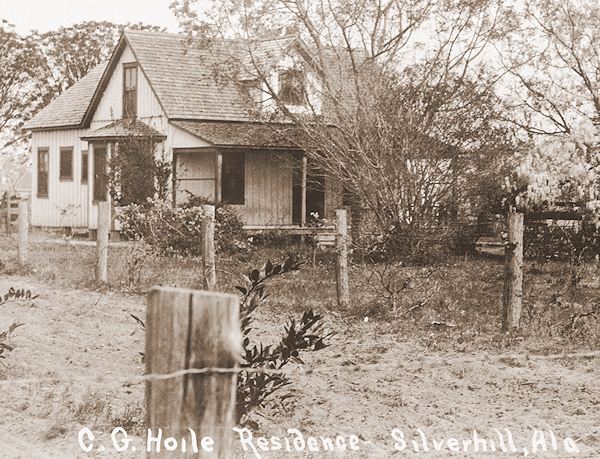
|
|
Hoiles home, Silverhill about 1913.
|
When they moved to Silverhill in 1912, the Hoiles family included Charles, his wife Hannah, and their three sons, ages 10, 7, and 5. The author of the newspaper article above questioned why Charles would build a store in the countryside, especially since the nearest community, a Swedish-speaking settlement, already had stores. Charles likely thought the air would be cleaner three miles away from the railroad in Robertsdale, which would benefit his family's health.
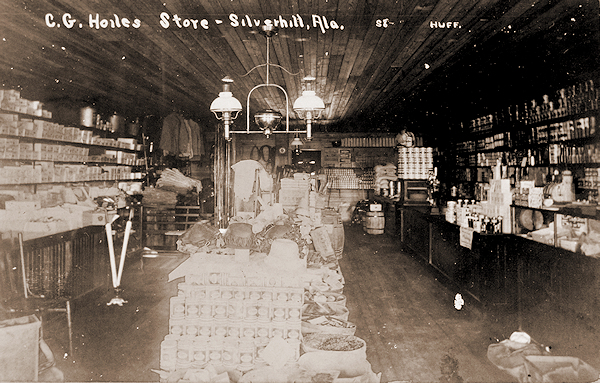
|
|
Hoiles Merchandise Store, Silverhill about 1913.
|
Within two years, the Hoiles family became deeply involved in the community. Hannah Hoiles was hosting parties and making friends in Silverhill and Robertsdale, even as her health was declining. It's hard not to wonder how many people might have been exposed to the contagious disease that Hannah was carrying.
Charles and Hannah had hoped that the clean country air would enhance Hannah's breathing, but her illness was too advanced to improve without the medicines that were yet to be invented.
In June 1914, Hannah was desperate enough to go back to Chicago to stay with her parents while she received medical treatment. Then, in October 1914, she traveled to a health resort in Black Mountain, North Carolina.
|
The Harrison Mountain Air Sanatorium of Black Mountain, North Carolina for tuberculosis therapy is possibly where Hannah received treatment. The rates at the Sanatorium were $20 to $35 per week. In 2024, the cost equivalent would have been about $630 to $1,100 per week.
|
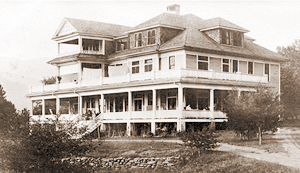
The Harrison Mountain Air Sanatorium of Black Mountain, North Carolina for tuberculosis therapy.
|
The Harrison Mountain Air Sanatorium was later know as the Cragmont Sanatorium. Postcards were addressed to her at the Cragmont and also the Gladstone in Black Mountain, North Carolina.
For a long time, doctors believed tuberculosis was hereditary, but had begun to observe that fresh air and outdoor living could sometimes change the course of the illness. Physicians were convinced clean mountain air was like medicine for the lungs.

Below are copies of postcards which Hannah Hoiles received while she was living at sanatoriums in Black Mountain, North Carolina.
Select each photo to enlarge.
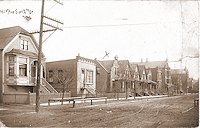
|
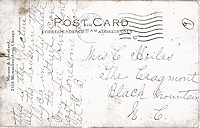
|
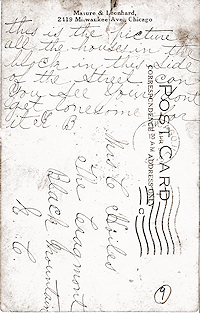
|
| Front of postcard mailed from Chicago, Ill. on April 9, unknown year. Mailed to Hannah at The Cragmont in Black Mountain, North Carolina.
|
Back of postcard mailed from Chicago, Ill. on April 9, unknown year. Mailed to Hannah at The Cragmont in Black Mountain, North Carolina.
|
Back of postcard mailed from Chicago, Ill. on April 9, unknown year. Mailed to Hannah at The Cragmont in Black Mountain, North Carolina.
|
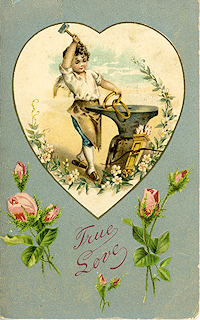
|
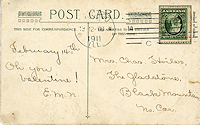
|
|
| Front of postcard mailed from Chicago, Ill. on Feb. 13, 1911. Mailed to Hannah at The Gladstone in Black Mountain, North Carolina.
|
Back of postcard mailed from Chicago, Ill. on Feb. 13, 1911. Mailed to Hannah at The Gladstone in Black Mountain, North Carolina.
|
|

Sadly, all the expense and effort that Charles had put his family through was unsuccessful in bringing back his wife's health. Hannah returned as an invalid to her home in Silverhill at the end of February. She was 32 years old. Her mother came from Chicago to care for her bedridden daughter.
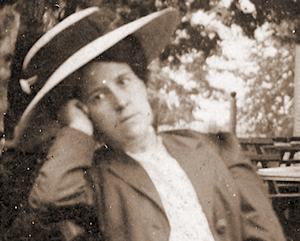
Hannah Hughes Hoiles.
|
The Onlooker on April, 7, 1915 reported that Hannah Hoiles had passed away on March 28, 1915, writing:
Although Mrs. Hoiles lived in Silverhill but two years and was in delicate health, yet, by her happy disposition and unfailing kindness she endeared herself to all... She was a woman of sterling character and good principles and a devoted wife and mother... Her husband Chas. G. Hoiles used every effort to restore her health.
|
|
After Hannah's death, Charles rented a building in Robertsdale to open a second store location. At the end of 1915, he had built his own store in Robertsdale.
The Robertsdale location produced more income than the Silverhill store. Perhaps people were afraid to visit the Silverhill location after Hannah had died from consumption, maybe they thought they would also catch it.
|
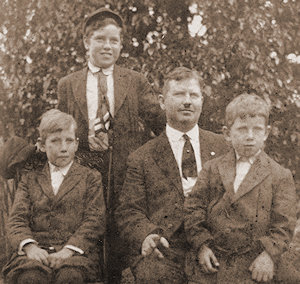
Charles Gee Hoiles and his three sons.
|
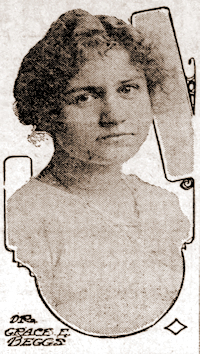
Dr. Grace E. Beggs.
|
At the age of 36, Charles married for a second time to Dr. Grace Beggs.
By spring of the next year, he had moved all of his goods out of the Silverhill store into the Robertsdale store. By August of 1916, the Hoiles family had also moved to Robertsdale permanently.
|
|
Charles' second marriage ended in 1917, but in 1918 he married Katharine Lederle who would become one of Robertsdale's "most loyal and beloved citizens."
|
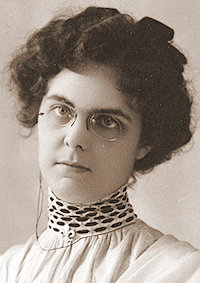
Katharine Lederle Hoiles.
|
Charles continued on to become a very successful merchant and a leader in the Robertsdale community.
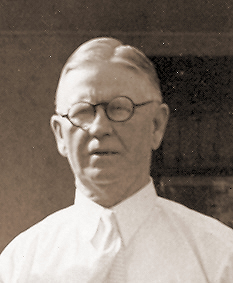
|
Always the business man looking to make a profit, Charles found a way to generate income from his 20 acres in Silverhill. In 1926, he drew up plans and a map to subdivide the land to be sold as smaller lots to build homes. The subdivision exists still today and remains known as Hoiles Heights.
See a PDF File of the Map here. The Trunk Line Road on the map is now County Road 55. This is the same area colored in red on the map below. The Trunk Line Road on the map is now County Road 55. This is the same area colored in red on the map below.
|

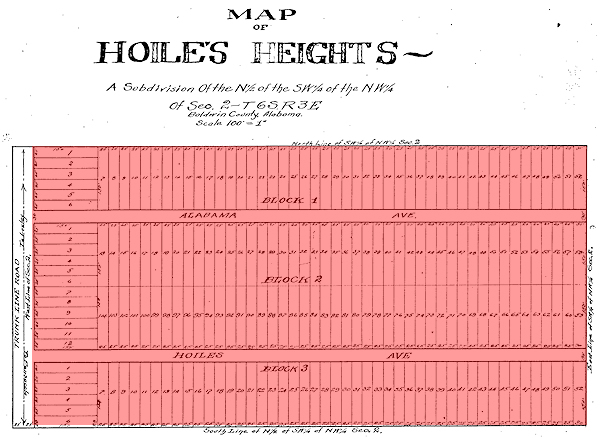
|
|
This is Hoiles Heights map of 1926. - Click to enlarge in PDF form.
|

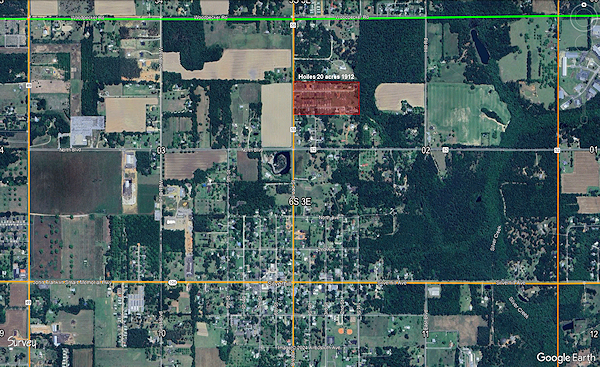
|
|
This is a recent satellite view of the 20 acres owned by Charles Gee Hoiles, highlighted in red. - Click to enlarge.
|

Location: The Charles G. Hoiles home and General Merchandise store of Silverhill, Alabama were about 0.70 miles north of the center of Silverhill on the east side of County Road 55, at the site that is now near 16015 Alabama Avenue, Silverhill, Alabama in the 20 acres that is the Hoiles Heights subdivision (colored on the map in red). These buildings no longer exist.
Latitude 30°33'22.61"N
Longitude 87°45'0.95"W

DEEDS and RECORDS
Charles G. Hoiles home and General Merchandise Store
DEED: On November 6, 1912, Olof J. Armstrong and wife Emma D. Armstrong sold 20 acres, to Chas. G. Hoils, filed April 7, 1928.
View JPG File of the deed.
Hoiles Heights
Subdivision of property: From the same 20 acres of land on which the merchandise store had been built, Charles G. Hoiles approved the subdivision of this land on August 21, 1926, filed August 27, 1926.
View PDF File of the Map 

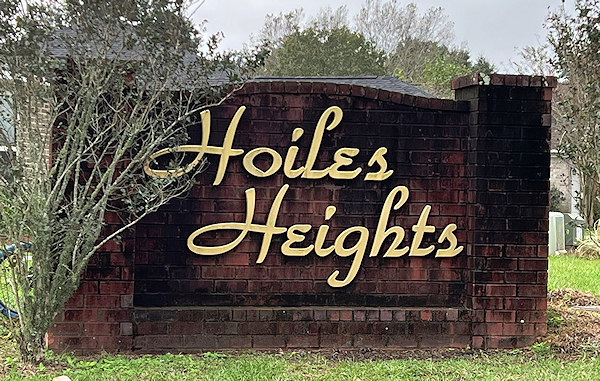
|
|
Hoiles Heights subdivision entrance Silverhill 2024.
|

Newspaper Clippings and Articles of
The Hoiles Store in Silverhill
Click each to enlarge or expand and read.
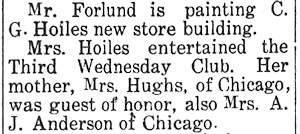
Newspaper Clipping taken from the Baldwin Times, February 05, 1914, page 4. Click to see larger article.
|
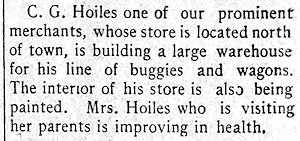
Newspaper Clipping taken from the Fairhope Courier, July 17, 1914, page 1.
|
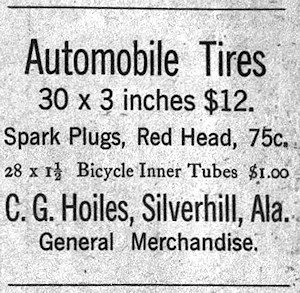
Newspaper Clipping taken from the Onlooker, Oct. 14, 1914, page 3.
|
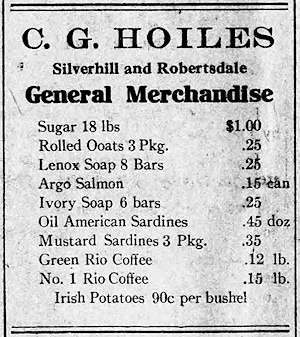
Newspaper Clipping taken from the Fairhope Courier, Oct. 28, 1915, page 6.
|
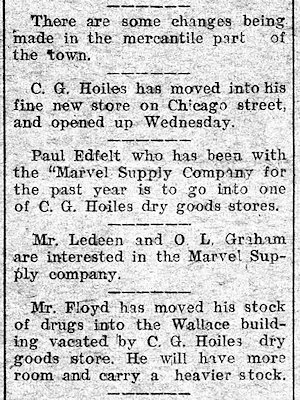
Newspaper Clipping taken from the Onlooker, Dec. 08, 1915, page 1. News about the Robertsdale businesses.
|
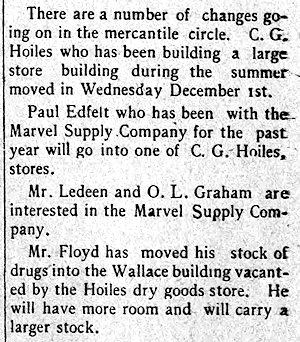
Newspaper Clipping taken from the Fairhope Courier, Dec. 10, 1915, page 1. News about the Robertsdale businesses.
|

Newspaper Clipping taken from the Baldwin Times, Feb. 24, 1916, page 2.
|

Newspaper Clipping taken from the Fairhope Courier, May 19, 1916, page 1.
|
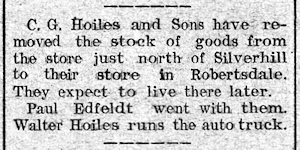
Newspaper Clipping taken from the Onlooker, May 24, 1916, page 1.
|

Newspaper Clipping taken from the Fairhope Courier, May 26, 1916, page 1.
|
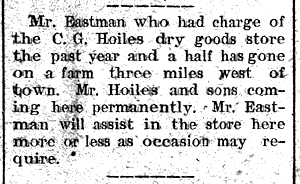
Newspaper Clipping taken from the Onlooker, Aug. 23, 1916, page 1. Robertsdale news information.
|
|

Below are photos of Hoiles stores and billboard
not located in Silverhill.
Click each photo to enlarge.
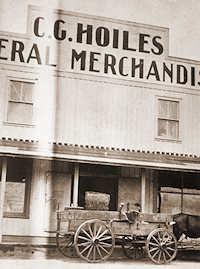
|
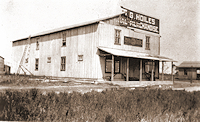
|
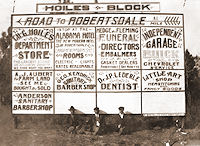
|
| C. G. Hoiles store with a horse-drawn cart out front, undated.
|
C. G. Hoiles store in Robertsdale with hurricane damage, 1916.
|
Billboard for the Hoiles Block, early 1920’s. Note the advertisement for "Dr. J. P. Lederle - Dentist." This was Dr. John Peter Lederle, brother of Katharine Lederle. He moved from Chicago to Robertsdale and set up an office in the Hoiles Block in 1922.
|
 Written November 2024
Written November 2024
by Debbie Owen

Resources
ChatGPT, ChatGPT 4.0 version, OpenAI, November 2024, "ChatGPT was used to revise content, and in the correction of spelling and grammar."
https://openai.com/
Hoiles, Jonathan (Great-great grandson of Charles Gee Hoiles). Email communication with Debbie Owen, containing photographs and Charles Gee Hoiles and Hannah Hughes family history written in 2019 by Jonathan Hoiles. Email November 2024.
Newspapers website. The Baldwin Times of Bay Minette, Alabama, and The Fairhope Courier of Fairhope, Alabama, and The Onlooker of Foley, Alabama.
https://www.newspapers.com/
Preservation Society of Asheville & Buncombe County.
The Royal League Sanatorium: A Surviving Reminder of the Fight Against the "White Plague",
By Dale Wayne Slusser, May 14, 2024.
https://psabc.org/
W3C Spell Checker. Online tool that will check the spelling of a web page.
https://www.w3.org

|